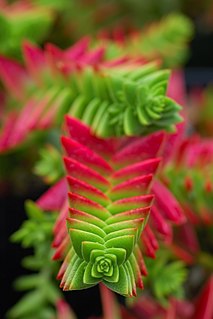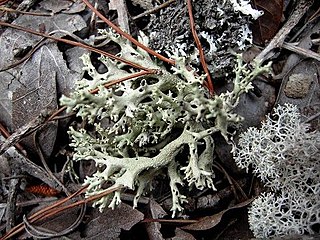
Cladonia is a genus of moss-like lichens in the family Cladoniaceae. They are the primary food source for reindeer and caribou. Cladonia species are of economic importance to reindeer-herders, such as the Sami in Scandinavia or the Nenets in Russia. Antibiotic compounds are extracted from some species to create antibiotic cream. The light green species Cladonia stellaris is used in flower decorations.

Crassula is a genus of succulent plants containing about 200 accepted species, including the popular jade plant. They are native to many parts of the globe, but cultivated varieties originate almost exclusively from species from the Eastern Cape of South Africa.

Paliurus is a genus of flowering plants in the family Rhamnaceae. The eight species are native to warm, dry regions of Eurasia and North Africa from Morocco and Spain east to Japan and Taiwan.
Odontocarya perforata is a species of plant in the Menispermaceae family. It is endemic to Ecuador.
Clelandella perforata is a species of sea snail, a marine gastropod mollusk in the family Trochidae, the top snails.
Babylonia perforata is a species of sea snail, a marine gastropod mollusk in the family Babyloniidae. It has been named after Italian journalist Piero Angela.
British NVC community OV9 is one of the open habitat communities in the British National Vegetation Classification system. It is one of eight arable weed and wasteland communities of fertile loams and clays.
British NVC community OV10 is one of the open habitat communities in the British National Vegetation Classification system. It is one of eight arable weed and wasteland communities of fertile loams and clays.
British NVC community OV13 is one of the open habitat communities in the British National Vegetation Classification system. It is one of eight arable weed and wasteland communities of fertile loams and clays.
British NVC community OV19 is one of the open habitat communities in the British National Vegetation Classification system. It is one of six communities characteristic of gateways, tracksides and courtyards.

Cladonia perforata is a rare species of lichen known by the common names Florida perforate cladonia and Florida perforate reindeer lichen. It is endemic to the state of Florida in the United States, where it is known from 16 populations in four widely separated areas of the state. It is native to a very specific type of Florida scrub habitat which is increasingly rare and patchy due to habitat destruction, degradation, and fragmentation. In 1993 this was the first species of lichen to be federally listed as an endangered species of the United States.
Paysonia perforata, known by the common name Spring Creek bladderpod, is a rare species of flowering plant in the mustard family. It is endemic to Tennessee in the United States, where it is known only from Wilson County. This very rare plant is threatened by the loss and degradation of its habitat. It is federally listed as an endangered species.

Akatea is the Māori name for at least two different species of white-flowering climbing vine from New Zealand:
Falsostesilea is a genus of longhorn beetles of the subfamily Lamiinae, containing the following species:

Crassula perforata is a succulent plant native to the Cape Provinces and KwaZulu-Natal in South Africa.
Estoloides perforata is a species of beetle in the family Cerambycidae. It was described by Bates in 1872. It is known from Curaçao, Mexico, Trinidad, and Venezuela.
Falsostesilea puncticollis is a species of beetle in the family Cerambycidae. It was described by Stephan von Breuning in 1940.
Nupserha perforata is a species of beetle in the family Cerambycidae. It was described by Stephan von Breuning in 1958. It is known from Ethiopia.
Saperda perforata is a species of beetle in the family Cerambycidae. It was described by Pallas in 1773, originally under the genus Cerambyx. It has a wide distribution in Europe. It feeds on Populus nigra, Populus alba, and Populus tremula. It is preyed upon by the parasitoid wasp Xorides indicatorius.
Zonitis perforata is a species of blister beetle in the family Meloidae. It is found in North America.






